Selecting and Editing Text
When you want to add, edit, format, copy, cut, or paste all or part of a shape's text, you first need to know how to select it, which Table 4-1 shows. You can move the insertion point by clicking anywhere in the text block or by using the arrow keys on the keyboard.
| Action | Tool | Technique |
|---|---|---|
| Select a text block |
| Click the Text Block tool, and then click a shape. |
| Open a shape's text block and select all the text in it |
| Do one of the following: Double-click the shape. Select the shape, and then press F2. |
| Display the insertion point |
| Open the text block as described in the preceding row of this table, and then click once. |
| Display the insertion point |
| Click a shape or text. |
| Select part of the text in a text block |
| Click a shape, and then drag to select the text you want. Or click at the start of the text you want, hold Shift, and then click at the end. |
| Select a word |
| Click a shape, and then double-click a word. |
| Select a paragraph |
| Click a shape, and then triple-click a paragraph. |
You select text when you're about to do something to it, such as copy, cut, or format it. Unless you want to work with individual words, you can simply select the shape, and then take an action. For example, to format a shape's text, you can select the shape, and then click a format. You don't necessarily have to use the Text tool to select the text you want to format.
Cross-Reference For details, see the section titled "Formatting Text" later in this chapter.
| Note | When you begin to type, Visio 2007 automatically zooms in on the drawing so that you can see what you are typing. To return to the original magnification, press the Esc key or click anywhere outside the shape or text block after you type the text. |
| Inside Out | Typing special characters If you use the Insert, Symbol command in Word 2007 or other Office 2007 programs, you might wonder how to add symbol and special characters in Visio 2007. You can insert ANSI characters into text. The ANSI character set consists of 256 characters established by the American National Standards Institute. How ANSI characters look on-screen depends on which font you are using. To type ANSI characters, follow these steps:
If you are using Microsoft Vista, Microsoft Windows XP or Microsoft Windows 2000, you can also do one of the following: Click Start, All Programs (click Programs in Windows 2000), Accessories, System Tools, Character Map. Select the font you wish to use and then choose the special character. Select it and then copy it. Return to Visio 2007 and paste it where you like. |
Cutting, Copying, and Pasting Text
You can cut, copy, or paste text within Visio 2007 diagrams and between other programs. The commands you use will look familiar if you use other Office programs, as Table 4-2 shows. Note that Visio 2007 allows you to copy text and its format so that you can paste it into another application. Visio 2007 pastes text in rich-text format, so formats are preserved.
| Action | Tool on Standard Toolbar | Keyboard Shortcut |
|---|---|---|
| Cut |
| Ctrl+X |
| Copy |
| Ctrl+C |
| Paste |
| Ctrl+V |
The text you copy or cut in Visio 2007 is temporarily stored in the Windows Clipboard. It remains in the Clipboard until you cut or copy something else, which allows you to copy a shape or text once and then paste it in multiple locations. (This is standard Windows behavior; it's not unique to Visio 2007 by any means.)
| Note | Instead of copying and pasting, you can duplicate shapes wholesale-text and all-with one command. Select a shape, and then press Ctrl+D (or choose Edit, Duplicate). Visio 2007 creates a copy and pastes it on the drawing page. |
Copying Text from Other Programs
You can also copy text from another program and paste it into Visio 2007. For best results, create a text-only shape, and then paste the text. For example, in Word 2007, select the text you want, and then press Ctrl+C to copy it. In Visio 2007, click the Text tool, drag to create a text-only shape in the location you want, and then press Ctrl+V to paste the Word text. Visio 2007 pastes the text and its formats.
Deleting Text from a Shape
When you delete text from a Visio 2007 shape, you remove only the text, not the text block. You can't delete a text block, but the good news is that a text block that does not contain any text isn't visible. If you delete all the text in a text-only shape, however, Visio 2007 also deletes the shape.
To delete text from a shape, follow these steps:
-
Click the Text tool on the Standard toolbar, and then click a shape.
Visio 2007 places the insertion point in the shape's text block.
-
Select the text you want, and then press the Delete key.
-
Press Esc or click outside the shape to close the text block.
To delete a text-only shape, select the shape with the Pointer tool, and then press the Delete key.
Adding and Repositioning Text on Lines and Connectors
You can add text to any line or connector (that is, any 1-D shape). Where the text ends up depends on the shape. If you draw a line, select it, and then type, Visio 2007 places your text on the center of the line, as Figure 4-6 shows. To make the text more readable, you can adjust the size and position of the shape's text block. By using the Format, Text command, you can choose a solid color to appear behind the text to make it more radable, as Figure 4-7 shows.
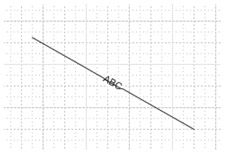
Figure 4-6: You can add text to any line you draw. By default, Visio 2007 centers the text on top of the line.
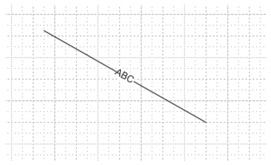
Figure 4-7: With the Format, Text command, you can choose a solid color to appear just behind the text to make it more readable.
| Note | Because the background color fills in the area around the text, the color only appears when a shape contains text. |
To put a solid background behind the text on a line, follow these steps:
-
Select a line, and then choose Format, Text.
-
Click the Text Block tab.
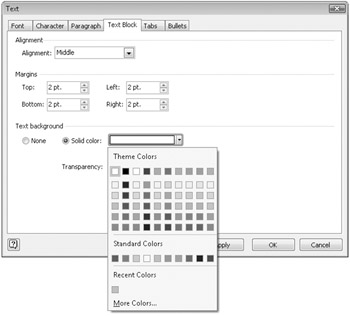
-
In the Text Background area, select Solid Color. To display a color other than white behind the text, choose a color from the list box.
-
Click OK.
Visio fills only the area behind the shape's text with the solid color you selected. If you type more text, the area of solid color is adjusted to match.
| Note | You can apply this procedure to any shape with text, not just lines. |
Repositioning Text on Lines and Connectors
If you're using one of the many line or connector shapes from a Visio 2007 stencil, as Figure 4-8 shows, you typically don't have to think about the text format. The Visio 2007 shape designer has done that for you, and you can just type and go. However, when you know the secrets to formatting text on lines, you can more easily customize the built-in connector shapes when you need to. For example, you can use the Text Block tool to move the location of the text on the line. To do this, click the Text Block tool, select the shape to display its text block, and then drag the text block to a new position. You can even drag the text block out of its associated shape.
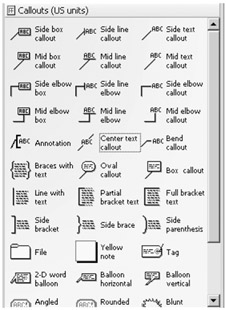
Figure 4-8: These shapes from the Callouts stencil are really just lines with specially formatted text (and a few SmartShape formulas thrown in for good measure). Use callout shapes to annotate your drawings.
Editing Locked Lines and Connectors
Many of the Visio 2007 callout and line shapes are locked to prevent the text from rotating as the line is dragged. Locking ensures that the text stays shiny side up when viewed on the page. You can tell that a shape is locked when you select it with the Text Block tool-padlock handles appear.
To rotate text on a locked shape, follow these steps:
-
Select the shape, and then choose Format, Protection.
-
The Protection dialog box appears, as shown in Figure 4-9. If the shape is locked to prevent rotation, the Rotation check box is selected.
-
Clear the Rotation check box, and then click OK.
On the drawing page, the padlock handles no longer appear on the selected shape.
-
Click the Text Block tool, click the shape, and then drag a round corner handle to rotate the text block.
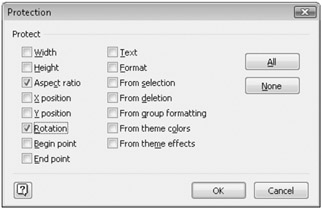
Figure 4-9: You can lock or unlock the rotational properties of just about any shape with a quick click in the Rotation box in the Protection dialog box.
Adding and Editing Text in Groups
Because groups are composed of several shapes, each of which can have a text block, adding text can be a little more involved than with other shapes.
In theory, here's how you can add and edit text in a group:
-
Click the Text tool, click a group, and then start typing to add text to the group's text block.
When you start typing, Visio 2007 zooms to 100 percent view so you can see the text more easily.
-
If the group contains a shape with additional text that you want to edit, click the shape again to select it separately from the group, and then type.
-
To close the text box, press Esc, or click outside the group.
| Note | To place an insertion point in one of a group's shapes, subselect the shape, and then click the Text tool. |
You can also use the Text Block tool to subselect shapes in a group and move or resize their text blocks.
Complications can arise when you're working with a Visio-designed group that has special behavior. Some groups include text that you cannot edit; others are locked against text entry altogether. The intention of the shape designers is to make the group behave properly, given its diagram context. Even so, if you want to add text to a locked or protected shape, you usually can-but the shape might not work the same afterward.
Cross-Reference For details about groups and behavior options, see the section titled "Working with Groups" in Chapter 22.
Adding Text on a Layer
In many offices that routinely create drawings such as blueprints or other plans, files are passed around for review, and reviewers add text comments directly to the drawing on a separate layer. Sometimes this process is called "redlining" a drawing, because review comments traditionally appear in red for certain drawings. Anyone can take advantage of this useful method of marking up a diagram or drawing in Visio 2007 without affecting the diagram itself, as Figure 4-10 shows. When you add text to a layer, you can format that layer differently to make the text easier to see or hide it temporarily to view only the diagram. You can also print the objects-including text-on just a particular layer.
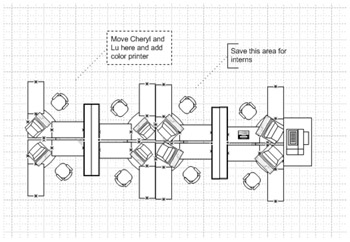
Figure 4-10: In this office layout, comments (which are shapes from the Callouts stencil) appear on a separate review layer so that comments can be hidden or printed separately.
After you create a new layer specifically for your comments, you designate it as the active layer. If you haven't used layers in Visio 2007 before, this might sound a little abstract, but all it means is that any objects you add to the drawing, including callout shapes or other text, will automatically be assigned to the layer. You can assign a color to the active layer, so that your comments are easier to see. A layer color doesn't change a shape's original color, but as long as the layer color is enabled, the shape is displayed using that color.
To create a separate layer for comments, follow these steps:
-
In the drawing to which you want to add comments, choose View, Layer Properties. The Layer Properties dialog box appears.
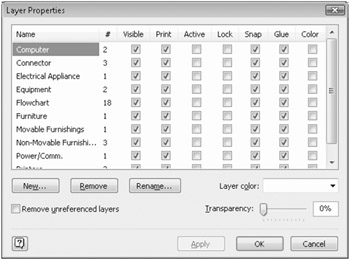
-
Click New. In the New Layer dialog box, type a name for the layer.
For example, type Review or Comments.
-
Click OK to close the New Layer dialog box.
In the Layer Properties dialog box, Visio 2007 adds the new layer to the list of layers and selects it.
-
Click in the Active column for your new layer.
A check mark appears next to the layer to show that it is the active layer for the drawing.
-
If you want your comments to appear in a particular color, click the drop-down arrow in the Layer Color box, and select a color.
The color you choose will be used to display all shapes and text assigned to your comments layer.
-
Click OK, and then type comments or add shapes in your drawing.
Shapes and text that you add are assigned to the comments layer and displayed in the layer color you selected. This does not apply for shapes that are added from the stencil you are currently working with, and it does not apply for the text added to those shapes either.
After you've created a comments layer and added text to it, you can selectively hide, show, and print your comments or change their color as follows:
-
If you want to hide the comments layer and view only the drawing, as Figure 4-11 shows, choose View, Layer Properties, and then clear the check mark in the Visible column for your comments layer. Click OK.
-
If you want to print only the comments, choose View, Layer Properties, and then clear the check mark in the Print column for every layer except your comments layer. Click OK, and then print the drawing.
-
If you want to view the comments in a different color, choose View, Layer Properties, select your comments layer, and then choose a different color in the Layer Color list. If you no longer want to use a layer color, clear the check mark in the Color column for your comments layer, and then click OK.
-
If you no longer want shapes and text to be assigned to your comments layer automatically, you must deactivate the layer. To do this, choose View, Layer Properties, and then clear the check mark in the Active column for your comments layer. Click OK.
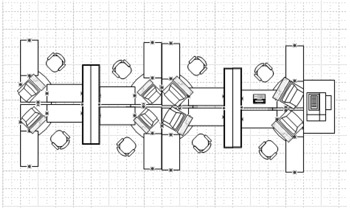
Figure 4-11: By unchecking the Visible checkbox for the comments layer, you can see your drawing alone, without the comments.
Layers are also a powerful tool for organizing shapes in a drawing.
Cross-Reference For details about using layers, see the section titled "Controlling Shapes with Layers" in Chapter 16, "Measuring and Dimensioning with Precision."
| Note | If more than one person is reviewing a drawing, create a redlining layer for each reviewer and give each layer a different display color. |
In fact, there might be times when you prefer to make comments by adding a text layer to a drawing. However, when this is not the case, you can use a new feature in Visio 2007, the Markup feature common to many Office programs. To access this feature, click Tools, Track Markup. This opens the Reviewing toolbar and the Review task pane.
To add a shape, drag it onto the drawing. Note that it appears in a different color. This shows that it is a change. To insert a comment, click Insert Comment on the Review task pane. The markup is translucent, so you can easily see the original drawing beneath the markup. For more information see the section titled "Collaborating with Your Fellow Workers" in Chapter 5, "Using Vision Diagrams on the Web."
EAN: 2147483647
Pages: 82






